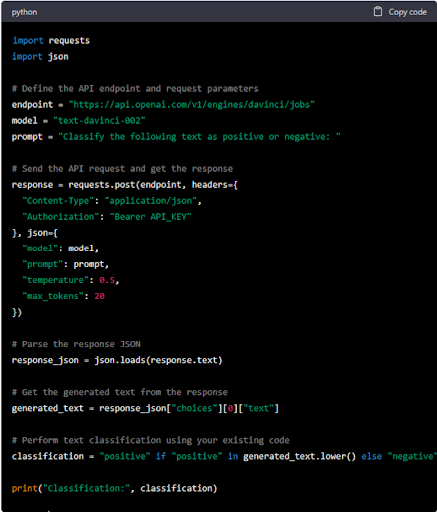Artificial intelligence (AI) is transforming the way we live and work, and OpenAI is at the forefront of this revolution. As a leader in AI research and development, OpenAI offers a suite of APIs that allow developers and businesses to harness the power of AI and add cutting-edge capabilities to their applications.
In this blog, we’ll guide you through the process of How to Integrate OpenAI’s APIs into Your AI Application.
Understanding OpenAI’s APIs
OpenAI offers a variety of APIs that developers can use to add AI capabilities to their applications.
These APIs can be broadly categorized into two types: pre-trained models and generative models.
Pre-trained models, such as the GPT-3 API, are AI models that have been trained on a massive amount of data and can be used for tasks such as text generation, question-answering, and language translation.
Generative models, on the other hand, are AI models that can generate new data that is similar to the data they have been trained on. The DALL-E API is an example of a generative model that can generate unique images based on textual descriptions.
OpenAI provides comprehensive API documentation and resources for developers, including tutorials, code samples, and forums for getting help and support. Before you start integrating OpenAI’s APIs into your AI application, it’s important to understand what is OpenAI API, what different APIs OpenAI has, their capabilities and limitations, and the resources available for help and support.
Preparing for Integration
To prepare for integrating OpenAI’s APIs into your AI application, you’ll need to follow these 4 steps:
- Create an OpenAI API account: To access OpenAI’s APIs, you’ll first need to create an account on the OpenAI website.
- Acquire API keys and authentication credentials: Once you have an account, you’ll be able to access your API keys and authentication credentials, which you’ll need to make API requests.
- Choose the API that best suits your needs: OpenAI offers a variety of APIs for different AI tasks, such as text generation, question-answering, and image generation. Choose the API that best suits your application’s needs and fits within your budget.
- Familiarize yourself with the API documentation: The OpenAI API documentation provides comprehensive information on the API, including request and response format, code samples, and tutorials. Make sure to read the documentation carefully before starting the integration process.
Interested in Using OpenAI’s APIs for Your Business?
Check out the custom AI software development and integration services
How to Integrate OpenAI’s APIs into Your AI Application
To integrate OpenAI’s APIs into your AI application, follow these 4 steps:
- Test the API using sample code: Before integrating the API into your application, it’s recommended to test the API using the sample code provided in the API documentation to ensure it works as expected.
- Incorporate the API into your application: Once you’ve tested the API and confirmed it works, you can incorporate the API into your application. This process may involve modifying your existing code and adding new code to handle API requests and responses.
- Test the integration: After integrating the API, it’s important to thoroughly test the integration to ensure it works as expected and that there are no compatibility issues with your existing code.
- Monitor the API usage: OpenAI’s APIs have usage limits and costs, so it’s important to monitor your API usage and ensure you stay within the usage limits and budget.
Here’s an example:
Let’s say you have an AI application that performs text classification, and you want to use OpenAI’s GPT-3 API to generate text.
First, you’ll need to test the API using the sample code provided in the API documentation to ensure it works as expected. Once you’ve confirmed that the API works, you can modify your existing code to handle API requests and responses.
For example, your code might look something like this:

After incorporating the API into your application, it’s important to thoroughly test the integration to ensure it works as expected and that there are no compatibility issues with your existing code. Finally, monitor your API usage to ensure you stay within the usage limits and budget.
Want Expert Guidance on Integrating OpenAI’s APIs into Your AI Application?
4 Benefits of Integrating OpenAI APIs into an AI Application
- Increased accuracy and efficiency of AI applications: Integrating OpenAI’s APIs into your AI application can greatly improve the accuracy and efficiency of your AI system.
OpenAI’s APIs are built using cutting-edge AI technologies and models that are constantly evolving, providing the most advanced and accurate AI solutions available. This can help you achieve better results and provide a more seamless user experience. Learn more about how different OpenAI APIs can be used by checking out this blog on examples of using OpenAI’s APIs.
- Access to cutting-edge AI technologies and models: By integrating OpenAI’s APIs into your AI application, you gain access to the latest and greatest AI technologies and models. This gives you a competitive edge and allows you to stay ahead of the curve in the rapidly-evolving AI space.
- Improved user experience and engagement: OpenAI’s APIs are designed to be user-friendly and interactive, offering a better user experience in your AI application.
With features such as natural language processing and sentiment analysis, you can provide a more engaging and personalized experience to your users.
- Cost savings compared to building AI models from scratch: Building AI models from scratch can be a time-consuming and expensive process. By incorporating OpenAI’s APIs into your AI application, you can save on development costs and time, allowing you to focus on other aspects of your business.
3 Challenges and Limitations of Integrating OpenAI’s APIs
- API rate limiting and usage restrictions: OpenAI’s APIs may have limitations on the rate at which they can be used, which can affect the performance of your AI application. It is important to understand and plan for these restrictions to ensure your AI application runs smoothly.
- API uptime and availability concerns: As with any API, there is always a risk of downtime or unavailability. This can affect the performance of your AI application and it’s important to plan for contingencies to minimize the impact of any downtime.
- Quality of results and limitations of the APIs: OpenAI’s APIs, like any AI technology, have limitations and may not provide the level of accuracy or performance desired in all cases. It’s important to understand the limitations of the APIs and plan accordingly to ensure the best possible results.
Frequently Asked Questions
What is the purpose of integrating OpenAI’s APIs into an AI application?
Integrating OpenAI’s APIs into an AI application can bring numerous benefits such as increased accuracy and efficiency, access to cutting-edge technologies and models, improved user experience, and cost savings.
Can I integrate OpenAI’s APIs into my AI application on my own?
Integrating OpenAI’s APIs into an AI application can be a complex process that requires a certain level of technical expertise. If you don’t have the necessary skills, it may be beneficial to seek the help of a professional software development company like www.spaceo.ai.
Can I use OpenAI’s APIs for commercial purposes?
Yes, you can use OpenAI’s APIs for commercial purposes, but you may need to sign up for a paid plan depending on your usage requirements.
Is there a cost involved in using OpenAI’s APIs?
Yes, OpenAI has different API plans with varying costs. Some of their APIs are free to use with limitations on usage, while others require a paid plan. You can check the pricing details on OpenAI’s website and choose a plan that best suits your needs.
Accelerate Your AI Project with the Support of OpenAI APIs
In conclusion, integrating OpenAI’s APIs into your AI application can bring numerous benefits such as increased accuracy and efficiency, access to cutting-edge technologies and models, improved user experience, and cost savings.
However, it is important to consider the challenges and limitations such as API rate limiting and usage restrictions, API uptime and availability concerns, and limitations of the results.
If you’re looking for help with custom software development for AI and OpenAI, look no further than www.spaceo.ai. Our team of experts has the skills and experience necessary to help you successfully integrate OpenAI’s APIs into your AI application and achieve your goals. Contact us today to learn more about how we can help you bring your AI project to life.


